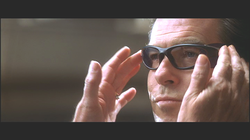Die Another Day Gadgets
Virtual Reality

The 1999 film The Matrix, paved the way for a developing technology to be exploited by movieworld, but Bond got in their first. A film that came out in the same year, Lawnmower Man, was also at the forefront of advertising the possibilities of the development to the viewing public.
In Die Another Day it is used for Bond’s retraining exercise, which is wholly realistic because US military training was implementing similar devices for training purposes at around that time.
In this scene, 007 appears to shoot M after discovering a dead Moneypenny post-terrorist attack on Mi6 HQ.
The tech was just ahead of its time enough for audiences to consider this to be part of the storyline. Not so, as the film ends though – Moneypenny finally gets it on with Bond. No, no, no, you can’t pull the wool over our eyes we know she’s got the glasses on! Sadly, this is the last time we see Moneypenny until the end of the third of Daniel Craig’s Bond films.
The glasses 007 uses are Oakley style and sufficiently ahead of their time to be considered one of the better Bond devices.
As the use of the technology was right on time for the screenwriters, their interpretation was perhaps fair enough. However, although the technology has proven useful for combat and pilot training among developed uses, it has proven difficult for the technologists and engineers to come even close to the perfect world images of the Die Another Day.
The limitation of processing power, image resolution and the other associated technologies that would require incorporation in Virtual Reality technology, has perhaps held the development back, but it may also be in part, the willingness of developers to take the tech onto the next step.
One obstacle block would be a transference of interest in holographic technology, but also 3D. Although the first 3D movie, Bwana Devil came out in 1952, and indeed, the early 1950s was a prolific time for the new technology, it was not until the early 2000s that the technology improved sufficiently for it to become the cinema staple that we are so used to now. The very fact that 3D televisions are flying off the tech shelves has left Virtual Reality struggling in the wake of 3D.
In Die Another Day it is used for Bond’s retraining exercise, which is wholly realistic because US military training was implementing similar devices for training purposes at around that time.
In this scene, 007 appears to shoot M after discovering a dead Moneypenny post-terrorist attack on Mi6 HQ.
The tech was just ahead of its time enough for audiences to consider this to be part of the storyline. Not so, as the film ends though – Moneypenny finally gets it on with Bond. No, no, no, you can’t pull the wool over our eyes we know she’s got the glasses on! Sadly, this is the last time we see Moneypenny until the end of the third of Daniel Craig’s Bond films.
The glasses 007 uses are Oakley style and sufficiently ahead of their time to be considered one of the better Bond devices.
As the use of the technology was right on time for the screenwriters, their interpretation was perhaps fair enough. However, although the technology has proven useful for combat and pilot training among developed uses, it has proven difficult for the technologists and engineers to come even close to the perfect world images of the Die Another Day.
The limitation of processing power, image resolution and the other associated technologies that would require incorporation in Virtual Reality technology, has perhaps held the development back, but it may also be in part, the willingness of developers to take the tech onto the next step.
One obstacle block would be a transference of interest in holographic technology, but also 3D. Although the first 3D movie, Bwana Devil came out in 1952, and indeed, the early 1950s was a prolific time for the new technology, it was not until the early 2000s that the technology improved sufficiently for it to become the cinema staple that we are so used to now. The very fact that 3D televisions are flying off the tech shelves has left Virtual Reality struggling in the wake of 3D.
Photo: Die Another Day 2002 Danjaq, LLC, & United Artists Corporation. All rights reserved
